Event
|
Description
|
PageIndexChanged
|
Occurs when one of the pager buttons is clicked, but after the GridView control handles the paging operation.
|
PageIndexChanging
|
Occurs when one of the pager buttons is clicked, but before the GridView control handles the paging operation.
|
RowCancelingEdit
|
Occurs when a row's Cancel button is clicked, but before the GridView control exits edit mode.
|
RowCommand
|
Occurs when a button is clicked in the GridView control.
|
RowCreated
|
Occurs when a new row is created in the GridView control.
|
RowDataBound
|
Occurs when a data row is bound to data in the GridView control. This event is often used to modify the contents of a row when the row is bound to data.
|
RowDeleted
|
Occurs when a row's Delete button is clicked, but after the GridView control deletes the record from the data source.
|
RowDeleting
|
Occurs when a row's Delete button is clicked, but before the GridView control deletes the record from the data source.
|
RowEditing
|
Occurs when a row's Edit button is clicked, but before the GridView control enters edit mode.
|
RowUpdated
|
Occurs when a row's Update button is clicked, but after the GridView control updates the row.
|
RowUpdating
|
Occurs when a row's Update button is clicked, but before the GridView control updates the row.
|
SelectedIndexChanged
|
Occurs when a row's Select button is clicked, but after the GridView control handles the select operation
|
Selected Index Changing
|
Occurs when a row's Select button is clicked, but before the GridView control handles the select operation.
|
Sorted
|
Occurs when the hyperlink to sort a column is clicked, but after the GridView control handles the sort operation.
|
Sorting
|
Occurs when the hyperlink to sort a column is clicked, but before the GridView control handles the sort operation.
|
How to gridview bind to
database?
|
Step-1
Take a Grid View on aspx page.
Write code as following
using System;
using System.Data;
using System.Linq;
using System.Web;
using System.Web.Security;
using System.Web.UI;
using System.Xml.Linq;
using System.Data.SqlClient;
public partial class GridviewBindingTODB
: System.Web.UI.Page
{
string constring = ConfigurationManager.ConnectionStrings["MyWebConfigString"].ConnectionString;
protected void
Page_Load(object sender, EventArgs e)
{
if (!IsPostBack)
{
GridViewBind();
}
}
private void
GridViewBind()
{
SqlConnection conn = new SqlConnection(constring);
conn.Open();
SqlCommand cmd = new SqlCommand("select * from producttable", conn);
SqlDataAdapter da = new SqlDataAdapter(cmd);
DataSet ds = new DataSet();
da.Fill(ds);
GridView1.DataSource = ds;
GridView1.DataBind();
}
}
|
In Grid view Select Row Item Using C# in ASP.Net 3.5.
|
Bind the Grid View
Control using C# code to display the items and implement the Select Command
functionality. Grid View Command
Field provides the automated functionality to execute the Select
command and change the appearance of selected row item, as shown below
Step-1
Create table(Person) in
DB
Step-2
Create new aspx
page(SelectRowExample.aspx)
First of all drag the Grid View control from Data
controls menu.
It will add the Grid View control
HTML source code as given above.
<asp:GridView ID="GridView1"
runat="server">
</asp:GridView>
Step-3
1.
CommandField-àAdd command field(Select)& sets
the properties
2
.SelectedRowStyle
Select
Grid view -àPropertes-à SelectedRowStyle
Grid View provides the auto Generate
Select Button property that accepts true or false. If auto Generate Select Button
property is set to true then Grid View Control automatically renders the
select button at runtime to select the row item. You can also use the Grid View Command
Field column to handle the GridView Select command. When you
specify a command as select for Command Field or auto
Generate Select Button="true" Grid View control
automatically handles the event to change the selected Row Index.
In this Example for Grid View Control Select Row, we have
used the database.mdf SQL database.
Step-4
After setting Command
Field & Selected Row Style HTML code like this
HTML Source code for
Grid view Select Row Example
<form id="form1"
runat="server">
<br />
<asp:GridView ID="GridView1" runat="server">
<Columns>
<asp:CommandField HeaderText="Select"
ShowHeader="True"
ShowSelectButton="True">
<HeaderStyle HorizontalAlign="Left" />
</asp:CommandField>
</Columns>
<SelectedRowStyle BackColor="Yellow" Font-Bold="True" BorderStyle="Inset" />
</asp:GridView>
</form>
Step-5
CSharp(C#) Source code
for Grid view Paging & Sorting
(SelectRowExample.aspx.CS)
using System.Data.SqlClient;//add namespace
public partial class SelectRowExample
: System.Web.UI.Page
{
string constring = ConfigurationManager.ConnectionStrings["MyWebConfigString"].ConnectionString;
protected
void Page_Load(object
sender, EventArgs e)
{
// The Page is accessed for the first time.
if (!IsPostBack)
{
// Populate the GridView.
BindGridView();
}
}
private void
BindGridView()
{
SqlConnection conn = new SqlConnection(constring);
// Create a SqlCommand object.
// Create a SELECT query.
SqlCommand cmd = new SqlCommand("select * from person", conn);
// Create a SqlDataAdapter object
// SqlDataAdapter represents a set of data
commands and a
// database connection that are used to fill
the DataSet and
// update a SQL Server database.
SqlDataAdapter da = new SqlDataAdapter(cmd);
// Create a DataSet object.
DataSet ds = new DataSet();
// Open the connection
conn.Open();
// Fill the DataTable named
"Person" in DataSet with the rows
//da.Fill(ds, "Person");
da.Fill(ds);
// Bind the GridView control.
GridView1.DataSource = ds;
GridView1.DataBind();
}
}
Output:
Build--àRun
|
Paging & Sorting Using C# in ASP.Net 3.5
Grid view.
|
ASP.Net 3.5 provides the sorting feature also in Grid View Control. You can
Paging & sort the
records displayed using Grid view control in ascending or descending order retrieved
from SQL database. You can use CSharp code to bind the SQL data with Grid View
control and follow the following simple steps to make your ASP.Net Grid View
control with sorting enabled.
Paging & Sorting Event
Ø onpageindexchanging="GridView1_PageIndexChanging"
Ø onsorting="GridView1_Sorting"
Step-1
Create table(Person) in
DB
Step-2
Create new aspx page(Paging&SortingExample.aspx)
First of all drag the Grid View control from Data
controls menu.
It will add the Grid View control
HTML source code as given above.
<asp:GridView ID="GridView2"
runat="server">
</asp:GridView>
Step-3
Now click on Grid View control to
load the control properties at right side panel.
To allow the paging
& sorting in Grid View control select True from the
dropdown list of Allow Paging & Allow Sorting property of
Grid view as shown in above image.
This will add AllowPaging="True"
& also set PageSize=5
or 10 or15 Value as
per your requirement AS WELL AS & AllowSorting="True" in HTML source
code of Grid View Control.
You can set Pager Setting value as follow
Step-4
Next step is to bind
the Paging & Sorting event for Grid View Control.
To bind the Paging
& Sorting event of Grid View control, double click on the Sorting event
in the properties viewer of Grid View. This will add the Sorting event in the
HTML source code and C# code for Grid view.
HTML Source code for
Grid view Paging & Sorting
<asp:GridView ID="GridView1"
runat="server"
AllowPaging="True"
AllowSorting="True"
onpageindexchanging="GridView1_PageIndexChanging"
onsorting="GridView1_Sorting"
PageSize="4">
<PagerSettings Mode="NumericFirstLast" />
</asp:GridView>
Step-5
CSharp(C#) Source code
for Grid view Paging & Sorting
(Paging&SortingExample.aspx.CS)
string constring = ConfigurationManager.ConnectionStrings["MyWebConfigString"].ConnectionString;
protected
void Page_Load(object
sender, EventArgs e)
{
// The Page is accessed for the first time.
if (!IsPostBack)
{
//
Enable the GridView paging option and
GridView1.AllowPaging = true;
//
specify the page size.
GridView1.PageSize = 5;
// Initialize the sorting expression.
ViewState["SortExpression"]
= "PersonID ASC";
// Populate the GridView.
BindGridView();
}
}
private void BindGridView()
{
SqlConnection conn = new SqlConnection(constring);
// Open the connection
conn.Open();
// Create a SqlCommand object.
// Create a SELECT query.
SqlCommand cmd = new
SqlCommand("select
* from person", conn);
// SqlCommand cmd = new
SqlCommand("SP_SelectPerson", conn);
// Create a SqlDataAdapter object
// SqlDataAdapter represents a set of data
commands and a
// database connection that are used to fill
the DataSet and
// update a SQL Server database.
SqlDataAdapter da = new SqlDataAdapter(cmd);
// Create a DataSet object.
DataSet ds = new DataSet();
// if I wrire like this da.Fill(ds); I got error
//Object reference not set to an instance of an object.
//so
don’t forget write like this
// Fill the DataTable named
"Person" in DataSet with the rows
da.Fill(ds, "Person");
// Get the DataView from Person DataTable.
DataView dv = ds.Tables["Person"].DefaultView;
// Set the sort column and sort order.
dv.Sort =
ViewState["SortExpression"].ToString();
// Bind the GridView control.
GridView1.DataSource = dv;
GridView1.DataBind();
}
//for PageIndex Changing
protected
void GridView1_PageIndexChanging(object sender, GridViewPageEventArgs
e)
{
GridView1.PageIndex = e.NewPageIndex;
// Populate the GridView.
BindGridView();
}
protected
void GridView1_Sorting(object sender, GridViewSortEventArgs
e)
{
string[] strSortExpression =
ViewState["SortExpression"].ToString().Split(' ');
// If the sorting column is the same as the
previous one,
// then change the sort order.
if (strSortExpression[0] ==
e.SortExpression)
{
if (strSortExpression[1] == "ASC")
{
ViewState["SortExpression"] = e.SortExpression +
" " + "DESC";
}
else
{
ViewState["SortExpression"] = e.SortExpression +
" " + "ASC";
}
}
// If sorting column is another column,
// then specify the sort order to
"Ascending".
else
{
ViewState["SortExpression"]
= e.SortExpression + " " + "ASC";
}
// Rebind the GridView control to show
sorted data.
BindGridView();
}
Output:
Build--àRun
|
Grid view Row Deleting Using C# in
ASP.Net 3.5.
|
ASP.Net Grid View control
provides a Command Field
that enables you to display the Delete Command button. You can easily attach
the Grid View event such as Row
Deleting to implement the delete command of Grid View control.
Row Deleting Event
Ø onrowdatabound="GridView1_RowDataBound"
Ø onrowdeleting="GridView1_RowDeleting"
Step-1
Create table(Person) in
DB
Step-2
Create new aspx page(DeleteExample.aspx)
First of all drag the Grid View control from Data
controls menu.
It will add the Grid View control
HTML source code as given above.
<asp:GridView ID="GridView1"
runat="server">
</asp:GridView>
Step-3
Then you have to set grid view
task as shown below
You have to add command fieldà 1) Edit,Update,Cancel & 2)Delete(Must be add both )
Step-4
After that you have to set Grid view EVENT
as follow
Grid view1 (Right Click)--àEvent-à 1) RowDeleting 2)RowDataBound
HTML Source code for
Grid view Row Deleting
<form id="form1"
runat="server">
<br />
<br />
<asp:GridView ID="GridView1"
runat="server"
onrowdatabound="GridView1_RowDataBound"
onrowdeleting="GridView1_RowDeleting">
<Columns>
<asp:CommandField ShowEditButton="True" />
<asp:CommandField ShowDeleteButton="True" />
</Columns>
</asp:GridView>
</form>
Step-5
CSharp(C#) Source code
for Grid view Row Deleting
(Row DeletingExample.aspx.CS)
using System.Data.SqlClient;
public partial class DeleteExamples
: System.Web.UI.Page
{
string constring = ConfigurationManager.ConnectionStrings["MyWebConfigString"].ConnectionString;
protected
void Page_Load(object
sender, EventArgs e)
{
// The Page is accessed for the first time.
if (!IsPostBack)
{
// Populate the GridView.
BindGridView();
}
}
private void BindGridView()
{
// Get the connection string from
Web.config.
// When we use Using statement,
// we don't need to explicitly dispose the
object in the code,
// the using statement takes care of it.
SqlConnection conn = new SqlConnection(constring);
// Open the connection
conn.Open();
// Create a SELECT query.
SqlCommand cmd = new SqlCommand("SELECT
PersonID,LastName,FirstName FROM Person", conn);
// Create a SqlDataAdapter object
// SqlDataAdapter represents a set of data
commands and a
// database connection that are used to fill
the DataSet and
// update a SQL Server database.
SqlDataAdapter da = new SqlDataAdapter(cmd);
// Create a DataSet object.
DataSet ds = new DataSet();
// Fill the DataTable named
"Person" in DataSet with the rows
// returned by the query.new n
//da.Fill(ds, "Person");
da.Fill(ds);
//Bind the GridView control.
//gvPerson.DataSource = dvPerson;
GridView1.DataSource = ds;
GridView1.DataBind();
}
protected
void GridView1_RowDataBound(object sender, GridViewRowEventArgs
e)
{
// Make sure the current GridViewRow is a
data row.
if (e.Row.RowType == DataControlRowType.DataRow)
{
// Make sure the current GridViewRow is
either
// in the normal state or an alternate row.
if (e.Row.RowState == DataControlRowState.Normal || e.Row.RowState == DataControlRowState.Alternate)
{
//
Add client-side confirmation when deleting.
((LinkButton)e.Row.Cells[1].Controls[0]).Attributes["onclick"] = "if(!confirm('Are
you certain you want to delete this person ?')) return false;";
}
}
}
protected
void GridView1_RowDeleting(object sender, GridViewDeleteEventArgs
e)
{
// Get the connection string from
Web.config.
// When we use Using statement,
// we don't need to explicitly dispose the
object in the code,
// the using statement takes care of it.
SqlConnection conn = new SqlConnection(constring);
// Open the connection
conn.Open();
// Create a command object.
SqlCommand cmd = new SqlCommand("DELETE FROM Person WHERE PersonID =
@PersonID", conn);
//SqlCommand cmd = new
SqlCommand("SP_DeletePerson", conn);
//// Set the command text
//// SQL statement or the name of the stored
procedure
//cmd.CommandText = "DELETE FROM Person
WHERE PersonID = @PersonID";
// Set the command type
// CommandType.Text for ordinary SQL
statements;
cmd.CommandType = CommandType.Text;
//Set the command type
// CommandType.StoredProcedure for stored
procedures.
// cmd.CommandType = CommandType.StoredProcedure;
// Get the PersonID of the selected row.
string strPersonID =
GridView1.Rows[e.RowIndex].Cells[2].Text;
// Append the parameter.
cmd.Parameters.Add("@PersonID",
SqlDbType.Int).Value = strPersonID;
// cmd.Parameters.AddWithValue("@PersonID",
strPersonID);
// Execute the command.
cmd.ExecuteNonQuery();
// Rebind the GridView control to show data
after deleting.
BindGridView();
}
}
Output:
Build--àRun
|
DropDownList Binding With DB
|
Step-1
Create table as citytable
Insert value in table
using System;
using System.Collections;
using System.Configuration;
using System.Data;
using System.Linq;
using System.Web;
using System.Web.Security;
using System.Web.UI;
using System.Web.UI.HtmlControls;
using System.Web.UI.WebControls;
using System.Web.UI.WebControls.WebParts;
using System.Xml.Linq;
using System.Data.SqlClient;
public partial class DropDownList
: System.Web.UI.Page
{
string
strconn = ConfigurationManager.ConnectionStrings["myconn"].ConnectionString;
protected
void Page_Load(object
sender, EventArgs e)
{
if
(!IsPostBack)
{
Bindddlcity();
}
}
protected void Bindddlcity()
{
SqlConnection
conn = new SqlConnection(strconn);
conn.Open();
SqlCommand
cmd = new SqlCommand("select * from citytable ",conn);
SqlDataAdapter
da = new SqlDataAdapter(cmd);
DataSet
ds = new DataSet();
da.Fill(ds);
//for
DropDownList1 binding
ddlcity.DataSource = ds;
ddlcity.DataTextField = "cname";
ddlcity.DataValueField = "cname";
ddlcity.DataBind();
//starting value set
DropDownList1.Items.Insert(0,"<select>");
}
}
OUTPUT
|
GridView with CheckBox – Select All and display
|
STEP-I:-Create new aspx page(GridViewWithCheckBox.aspx)
GridView Tasks---àEdit Columns-àfield wised open as shown below.
Then add Boundfield
-àProductID, ProductName,
UnitInSystem, PrizePerUnit .
Then add TemplactField as shown below
Then
Then as shown in below
Then add
Then write Javascript in source code
<head
runat="server">
<script language="javascript">
function SelectAllCheckboxes(spanChk){
// Added as ASPX uses SPAN for checkbox
var oItem = spanChk.children;
var theBox= (spanChk.type=="checkbox")
?
spanChk :
spanChk.children.item[0];
xState=theBox.checked;
elm=theBox.form.elements;
for(i=0;i<elm.length;i++)
if(elm[i].type=="checkbox"
&&
elm[i].id!=theBox.id)
{
//elm[i].click();
if(elm[i].checked!=xState)
elm[i].click();
//elm[i].checked=xState;
}
}
</script>
<title>Untitled
Page</title>
</head>
Just add function
<asp:TemplateField HeaderText="Select
" >
<HeaderTemplate>
<asp:Label ID="Label1"
runat="server"
Text="Select
All"></asp:Label>
<input ID="chkAll" runat="server"
onclick="javascript:SelectAllCheckboxes(this);" title="Select"
type="checkbox" />
</HeaderTemplate>
<ItemTemplate>
<%--this checkbox id write in
FindControl("CheckBox1")--%>
<asp:CheckBox ID="CheckBox3"
runat="server"
/>
</ItemTemplate>
Then
string
constring = ConfigurationManager.ConnectionStrings["MyWebConfigString"].ConnectionString;
protected void
Page_Load(object sender, EventArgs e)
{
if (!IsPostBack)
{
GridBind();
}
}
private void GridBind()
{
SqlConnection conn = new
SqlConnection(constring);
SqlCommand cmd = new
SqlCommand("select
* from producttable", conn);
SqlDataAdapter da = new
SqlDataAdapter(cmd);
DataSet ds = new
DataSet();
da.Fill(ds);
GridView1.DataSource = ds;
GridView1.DataBind();
}
}
protected void Button1_Click(object sender, EventArgs
e)
{
// StringBuilder object
StringBuilder str = new
StringBuilder();
// Select the checkboxes from the GridView control
for (int i = 0; i
< GridView1.Rows.Count; i++)
{
GridViewRow row = GridView1.Rows[i];
bool isChecked = ((CheckBox)row.FindControl("CheckBox3")).Checked;
// bool isChecked =
((CheckBox)row.FindControl("LinkButton2")).Checked;
if (isChecked)
{
// Column 2 is the name column to change Cells[1,2,3,4,5
like this]
str.Append(GridView1.Rows[i].Cells[4].Text);
}
}
// prints out the result in TextBox1
TextBox1.Text
= str.ToString();
Response.Write(str.ToString());
// prints out the result in GridView2
//GridBind1();
}
Check OUTPUT
|
Select Multiple CheckBox For Delete data form database |
|
<%@ Page Title="" Language="C#" MasterPageFile="~/UserArea/UserArea.master" AutoEventWireup="true"
CodeFile="Inbox3.aspx.cs"
Inherits="UserArea_Inbox3"
%>
<asp:Content ID="Content1" ContentPlaceHolderID="HeadContent" Runat="Server">
<script language="javascript">
function SelectAllCheckboxes(spanChk)
{
//
Added as ASPX uses SPAN for checkbox
var
oItem = spanChk.children;
var
theBox = (spanChk.type == "checkbox")
?
spanChk : spanChk.children.item[0];
xState = theBox.checked;
elm = theBox.form.elements;
for
(i = 0; i < elm.length; i++)
if
(elm[i].type == "checkbox"
&&
elm[i].id != theBox.id) {
//elm[i].click();
if (elm[i].checked != xState)
elm[i].click();
//elm[i].checked=xState;
}
}
</script>
</asp:Content>
<asp:Content ID="Content2" ContentPlaceHolderID="MainContent" Runat="Server">
<div align="center">
<asp:GridView ID="GrdReport" runat="server" AutoGenerateColumns="False" Width="50%"
BackColor="White" CellPadding="4" ForeColor="Black" GridLines="Vertical" DataKeyNames="compid"
OnRowDataBound="Grd_Download_RowDataBound" CssClass="BugGridview
"
OnSelectedIndexChanged="GrdReport_SelectedIndexChanged" AllowPaging="True"
onpageindexchanging="GrdReport_PageIndexChanging">
<AlternatingRowStyle BackColor="White" />
<Columns>
<%--<asp:TemplateField>
<HeaderTemplate>
<input ID="chk123" runat="server"
onclick="javascript:SelectAllCheckboxes(this);"
title="Select" type="checkbox" />
<asp:Label ID="Label1" runat="server"
Text="Select All"></asp:Label>
</HeaderTemplate>
<ItemTemplate>
<asp:CheckBox ID="CheckBox3" runat="server"
/>
</ItemTemplate>
</asp:TemplateField>--%>
<asp:TemplateField><HeaderTemplate>
<input ID="chk123"
runat="server"
onclick="javascript:SelectAllCheckboxes(this);"
title="Select"
type="checkbox"
/>
<asp:Label ID="Label1"
runat="server"
Text="Select
All"></asp:Label>
</HeaderTemplate>
<ItemTemplate>
<asp:CheckBox ID="chk123"
runat="server"
/>
</ItemTemplate>
</asp:TemplateField>
<asp:TemplateField HeaderText="Compid">
<ItemTemplate>
<asp:Label ID="lblBugId"
runat="server"
Text='<%#Bind("compid")%>'></asp:Label>
</ItemTemplate>
</asp:TemplateField>
<asp:TemplateField HeaderText="From">
<ItemTemplate>
<asp:Label ID="lblBugName"
runat="server"
Text='<%#Bind("ActionBy") %>'></asp:Label>
</ItemTemplate>
</asp:TemplateField>
<asp:TemplateField HeaderText="Subject">
<ItemTemplate>
<asp:Label ID="lblBugDescription"
runat="server"
Text='<%#Bind("Subject") %>'></asp:Label>
</ItemTemplate>
</asp:TemplateField>
<asp:TemplateField HeaderText="Attachments">
<ItemTemplate>
<%--
<asp:LinkButton ID="lbtnAttachments"
runat="server" Text="Download"
Font-Underline="true"></asp:LinkButton>--%>
<asp:HyperLink ID="Hyplnk_Attachments"
runat="server"
Font-Underline="true"
NavigateUrl='<%# Eval("compid",
"GetFile.aspx?ID={0}&Attachmentid=1") %>'
Text="Download"
ForeColor="Blue"></asp:HyperLink>
</ItemTemplate>
</asp:TemplateField>
<asp:TemplateField HeaderText="Status">
<ItemTemplate>
<asp:LinkButton ID="lbtnStatus"
runat="server"
Text="View"
Font-Underline="true"
CommandName="Select"></asp:LinkButton>
</ItemTemplate>
</asp:TemplateField>
<asp:TemplateField HeaderText="Action">
<ItemTemplate>
<asp:LinkButton ID="lbtnEdit" runat="server" Text="Edit" CommandName="Edit" Font-Underline="true"></asp:LinkButton>
</ItemTemplate>
</asp:TemplateField>
</Columns>
<FooterStyle BackColor="#CCCC99" />
<HeaderStyle CssClass="BugGridHeader " />
<PagerStyle BackColor="#F7F7DE" ForeColor="Black" HorizontalAlign="Right" />
<RowStyle BackColor="#F7F7DE" />
<SelectedRowStyle BackColor="#CE5D5A" Font-Bold="True" ForeColor="White" />
<SortedAscendingCellStyle BackColor="#FBFBF2" />
<SortedAscendingHeaderStyle BackColor="#848384"
/>
<SortedDescendingCellStyle BackColor="#EAEAD3" />
<SortedDescendingHeaderStyle BackColor="#575357"
/>
</asp:GridView>
</div>
<table>
<tr>
<td>
<asp:Button ID="btn" runat="server" Text="delete" OnClick="btn1_Click" />
</td>
<td>
<%--
<headertemplate> <asp:ImageButton ID="ImageButton1"
runat="server" ImageUrl="~/images.jpg" Height="20px"
Width="24px"
onclick="btn1_Click" /></headertemplate>--%>
</td>
</tr>
</table>
</asp:Content>
In C# Code
using System;
using System.Collections.Generic;
using System.Linq;
using System.Web;
using System.Web.UI;
using System.Web.UI.WebControls;
using System.Configuration;
using System.Data.SqlClient;
using System.Data;
using System.Collections.Specialized;
using System.Text;
using System.Collections;
public partial class UserArea_Inbox3
: System.Web.UI.Page
{
string
constring = ConfigurationManager.ConnectionStrings["dbconnection"].ConnectionString;
DataSet
ds = new DataSet();
string r;
protected void
Page_Load(object sender, EventArgs e)
{
if
(!IsPostBack)
{
GridViewBind();
}
}
private void GridViewBind()
{
SqlConnection
conn = new SqlConnection(constring);
conn.Open();
SqlCommand
cmd = new SqlCommand("Select * from Compose", conn);
SqlDataAdapter
ad = new SqlDataAdapter(cmd);
DataSet
ds = new DataSet();
ad.Fill(ds, "compose");
GrdReport.DataSource = ds;
GrdReport.DataBind();
}
protected
void btn1_Click(object
sender, EventArgs e)
{
StringCollection
sc = new StringCollection();
//for (int
i = 0; i < GrdReport.Rows.Count; i++)
foreach
(GridViewRow gvrow in GrdReport.Rows)
{
CheckBox
cb = (CheckBox)gvrow.FindControl("chk123"); //find
the CheckBox
//CheckBox
cb = (CheckBox)GrdReport.FindControl("chk123"); //find the CheckBox
if
(cb != null)
{
if
(cb.Checked)
{
int
usrid = Convert.ToInt32(GrdReport.DataKeys[gvrow.RowIndex].Value);
//string
id = GrdReport.Rows[i].Cells[1].Text;
sc.Add(usrid.ToString());
//sc.Add(id.ToString());
DeleteRecords(sc);
}
}
}
GridViewBind();
}
private void DeleteRecords(StringCollection
sc)
{
SqlConnection
conn = new SqlConnection(constring);
//StringBuilder
sb = new StringBuilder(string.Empty);
try
{
conn.Open();
foreach
(string item in
sc)
{
//SqlCommand
cmd = new SqlCommand("delete from compose where compid=" + item,
conn);
//cmd.ExecuteNonQuery();
SqlConnection con = new SqlConnection(constring);
SqlCommand
cmd = new SqlCommand("Delete_Inbox_SP", con);
cmd.CommandType = CommandType.StoredProcedure;
cmd.Parameters.AddWithValue("@compid", item);
cmd.Connection = con;
con.Open();
cmd.ExecuteNonQuery();
con.Close();
}
}
catch
(System.Data.SqlClient.SqlException ex)
{
string
msg = "Deletion Error:";
msg += ex.Message;
throw
new Exception(msg);
}
finally
{
conn.Close();
}
}
protected
void Grd_Download_RowDataBound(object sender, GridViewRowEventArgs
e)
{
if
(e.Row.RowType == DataControlRowType.DataRow)
{
//int
id = Convert.ToInt16((e.Row.FindControl("lblBugId") as
Label).Text);
//Functions
objfn = new Functions();
//DataTable
file = new DataTable();
//file
= objfn.GetAFile(id);
//DataRow
row = file.Rows[0];
//if
(file.DefaultView[0]["AttachmentName"].ToString().Trim() ==
"")
//{
// (e.Row.FindControl("Hyplnk_Attachments")
as HyperLink).Visible = false;
//}
}
}
protected
void GrdReport_SelectedIndexChanged(object sender, EventArgs
e)
{
}
{
GrdReport.PageIndex =
e.NewPageIndex;
GridViewBind();
}
}
Note:-For Update purpose
just change Stored procedure & method(UpdateRecord) all other are same.
Change stored procedure query
as following screen
CHANGE method update method as following c# code
private void
UpdateRecords(StringCollection sc)
{
SqlConnection
conn = new SqlConnection(constring);
//StringBuilder
sb = new StringBuilder(string.Empty);
try
{
conn.Open();
foreach
(string item in
sc)
{
////SqlCommand
cmd = new SqlCommand("delete from compose where compid=" + item,
conn);
//SqlCommand
cmd = new SqlCommand("update compose set flage='True' where
compid=" + item, conn);
//cmd.ExecuteNonQuery();
//using
stored procedure
SqlConnection con = new
SqlConnection(constring);
SqlCommand
cmd = new SqlCommand("Update_ComposeInbox_SP", con);
cmd.CommandType = CommandType.StoredProcedure;
cmd.Parameters.AddWithValue("@compid", item);
cmd.Connection = con;
con.Open();
cmd.ExecuteNonQuery();
int
j = cmd.ExecuteNonQuery();
if
(j > 0)
{
lblerror.Text = "Deleted successfully";
}
else
{
lblerror.Text = "Not
Deleted";
}
con.Close();
}
}
catch
(System.Data.SqlClient.SqlException ex)
{
string
msg = "Deletion Error:";
msg += ex.Message;
throw new Exception(msg);
}
finally
{
conn.Close();
}
}
|
How
to insert data using radio buttons
value in male or female?
|
For
an example I am create simple page in that page I placed a textbox, two radio
button for male or female
Client side code
I have places some controls in client side of the web page (is called ExampleOFRadioButton.aspx) and shown in below figure.
Server side
protected void
btninsert_Click(object sender, EventArgs e)
{
SqlConnection conn = new SqlConnection(constring);
try
{
if
(TextBox1.Text!=string .Empty && RadioButton1.Checked!=false || RadioButton2.Checked!=false )
{
conn.Open();
SqlCommand cmd = new SqlCommand("sp_addtbl1",
conn);
cmd.CommandType = CommandType.StoredProcedure;
SqlParameter eid = new SqlParameter("@eid",
System.Data.SqlDbType.BigInt);
SqlParameter ename = new SqlParameter("@ename", System.Data.SqlDbType.VarChar, 50);
SqlParameter gender = new SqlParameter("@gender", System.Data.SqlDbType.Char, 6);
SqlParameter actionby = new SqlParameter("@actionby", System.Data.SqlDbType.VarChar, 50);
SqlParameter actiondate = new
SqlParameter("@actiondate",
System.Data.SqlDbType.DateTime);
cmd.Parameters.AddWithValue("@eid", TextBox4.Text);
cmd.Parameters.AddWithValue("@ename", TextBox1.Text);
string g = "";
if
(RadioButton1.Checked)
g = RadioButton1.Text;
else
g = RadioButton2.Text;
cmd.Parameters.AddWithValue("@gender",
g);
cmd.Parameters.AddWithValue("@actionby", TextBox1.Text);
cmd.Parameters.AddWithValue("@actiondate", DateTime.Now);
cmd.ExecuteNonQuery();
Response.Write("<script>alert('Record
Inserted!!!!!')</script>");
GridBind();
ClearAll();
}
else
{
Response.Write("Please enter all field carfully!!!!");
}
}
catch (Exception)
{
throw;
}
finally
{
conn.Close();
}
}
OUTPUT
Client code
<html xmlns="http://www.w3.org/1999/xhtml">
<head runat="server">
<title>Untitled Page</title>
<style type="text/css">
.style1
{
width: 344px;
background-color: #C0C0C0;
height: 218px;
}
.style2
{
width: 107px;
}
.style4
{
width: 149px;
}
.style6
{
width: 73px;
}
</style>
</head>
<body>
<form id="form1"
runat="server">
<table class="style1">
<tr>
<td
class="style2">
</td>
<td
class="style6">
<asp:TextBox ID="TextBox4" runat="server" ReadOnly="True" Visible="False"></asp:TextBox>
</td>
<td
class="style4">
</td>
</tr>
<tr>
<td
class="style2">
Employee Name:</td>
<td
class="style6">
<asp:TextBox ID="TextBox1" runat="server"></asp:TextBox>
</td>
<td
class="style4">
</td>
</tr>
<tr>
<td
class="style2">
Gender:</td>
<td
class="style6">
<asp:RadioButton ID="RadioButton1" runat="server" Text="Male"
GroupName="gender" />
</td>
<td
class="style4">
<asp:RadioButton ID="RadioButton2" runat="server" Text="Female"
GroupName="gender" />
</td>
</tr>
<tr>
<td
class="style2">
</td>
<td
class="style6">
<asp:Button ID="btninsert" runat="server" Height="27px"
onclick="btninsert_Click" Text="Insert "
Width="108px"
/>
</td>
<td
class="style4">
</td>
</tr>
<tr>
<td
class="style2">
</td>
<td
class="style6">
</td>
<td
class="style4">
<asp:GridView ID="GridView1" runat="server">
</asp:GridView>
</td>
</tr>
</table>
<p>
</p>
</form>
</body>
</html>
|


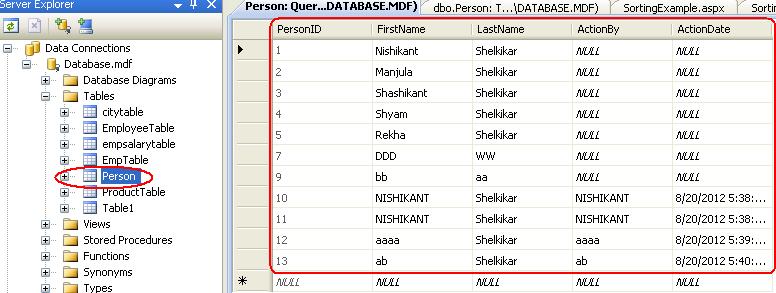




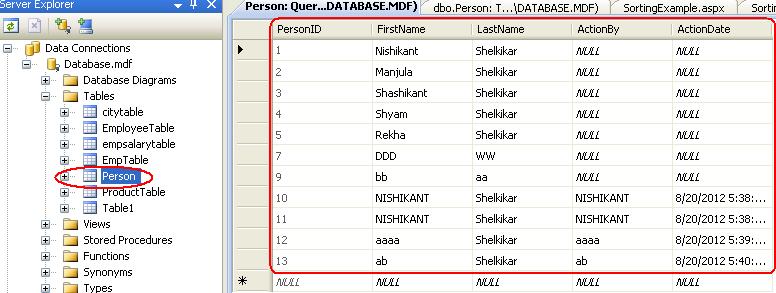









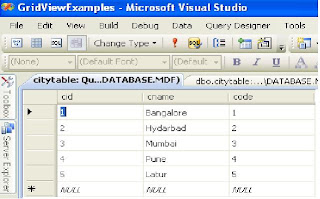



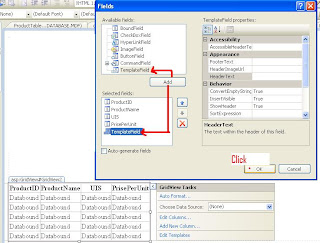








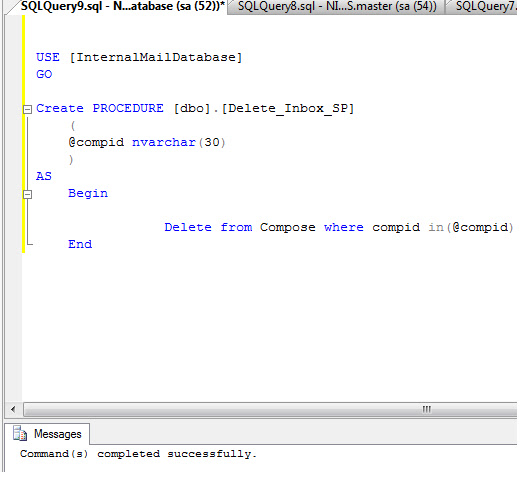



No comments:
Post a Comment